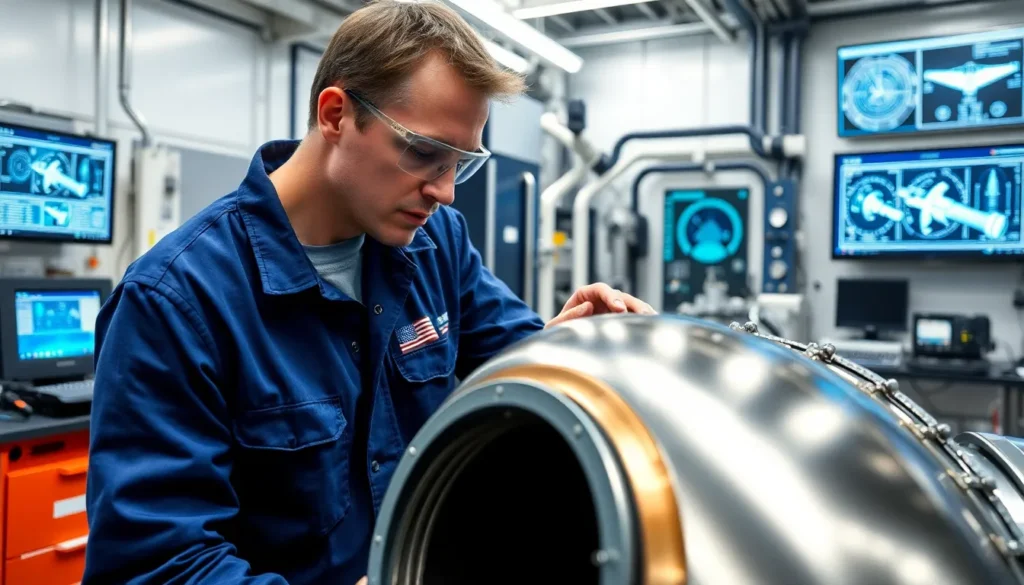Table of Contents
ToggleIn a world where space exploration is no longer a distant dream, rocket systems innovation takes center stage. As private companies and government agencies race to push the boundaries of what’s possible, advancements in propulsion technology, materials science, and automation are transforming the aerospace landscape. These innovations not only enhance performance but also pave the way for sustainable space travel.
From reusable rockets that dramatically reduce costs to advanced satellite deployment systems, the future of rocketry is bright. As engineers and scientists collaborate to develop cutting-edge solutions, the potential for exploration beyond our planet expands. This article delves into the latest breakthroughs in rocket systems, highlighting the key players and technologies shaping the next era of space exploration.
Overview of Rocket Systems Innovation
Rocket systems innovation encompasses advancements in propulsion technology, materials science, automation, and design. Innovations lead to improved performance, increased efficiency, and enhanced safety in space exploration.
Propulsion Technology
Propulsion technology advancements focus on developing more efficient engines. These engines use liquid and solid rocket fuels, enabling higher thrust-to-weight ratios. The introduction of reusable engines—such as SpaceX’s Merlin engine—reduces costs while maintaining reliability.
Materials Science
Materials science plays a crucial role in rocket construction. Lightweight, heat-resistant materials, such as carbon fiber composites and advanced alloys, enhance structural integrity while lowering weight. These materials withstand extreme conditions in space, allowing for longer missions and safer travel.
Automation
Automation streamlines operations in rocket systems. Autonomous flight systems and ground control technologies reduce the need for human intervention, increasing precision and minimizing errors. Innovations in artificial intelligence support real-time decision-making, resulting in increased mission success rates.
Reusable Rockets
Reusable rockets have transformed the aerospace industry. By enabling multiple flights from a single vehicle, they cut launch costs significantly. Companies like Blue Origin and SpaceX exemplify successful reusability models, showcasing sustainability and efficiency in space missions.
Satellite Deployment Systems
Innovations in satellite deployment systems improve capabilities for deploying multiple satellites simultaneously. Techniques like ridesharing increase launch efficiency and reduce costs for providers. These systems enhance communication, GPS, and Earth observation, further expanding the possibilities of space applications.
Collaborative Efforts
Collaborative efforts among private companies, government agencies, and international partners drive rapid innovation. These partnerships leverage diverse expertise and resources, facilitating breakthroughs in technology, policy, and exploration strategies. Such collaboration enhances the collective ability to push the boundaries of space exploration.
Rocket systems innovation is poised to revolutionize how humanity explores and utilizes space, significantly impacting future endeavors beyond Earth.
Key Technologies Driving Innovation

Rocket systems innovation relies heavily on advancements in several key technologies, significantly enhancing capabilities in space exploration.
Propulsion Systems
Propulsion systems represent a pivotal area of innovation. Efficient engines, like SpaceX’s reusable Merlin engine, demonstrate significant cost reductions alongside robust performance. Advanced propulsion technologies include liquid and solid rocket engines that provide higher thrust and improved fuel efficiency. Hybrid rocket engines combine advantages from both liquid and solid systems, offering enhanced control and safety. Ongoing research into green propellants aims to reduce environmental impact, making launches more sustainable. The advent of electric propulsion, such as ion thrusters, improves long-duration missions by optimizing fuel usage with higher specific impulse.
Avionics and Navigation
Avionics and navigation technologies drive precision in rocket systems. Advanced avionics systems integrate sophisticated algorithms and real-time data processing, enabling autonomous flight. GPS technology enhances navigation accuracy for launch trajectories and in-orbit maneuvers. Inertial navigation systems (INS) provide reliable positioning by using onboard sensors to calculate movement without external references. Innovations in communications technology, including laser communication systems, increase data transfer rates between spacecraft and ground stations. These advancements ensure improved reliability and efficiency, key to successful space missions.
Recent Breakthroughs in Rocket Systems
Recent advancements in rocket systems highlight groundbreaking innovations that enhance efficiency and sustainability in space exploration.
Reusable Rocket Technology
Reusable rocket technology transforms the launch landscape, significantly reducing cost per flight. SpaceX’s Falcon 9, featuring a fully reusable first stage, has completed over 150 successful missions, demonstrating reliability and reusability. Blue Origin’s New Shepard also showcases advancements with its reusable suborbital vehicles, supporting research and tourism. The rapid turnaround times achieved with these systems allow for more frequent launches, maximizing utilization and lowering barriers to access space.
Miniaturized Launch Vehicles
Miniaturized launch vehicles enable the launch of small satellites at reduced costs. Companies like Rocket Lab and Astra focus on this growing market segment, offering affordable launch solutions for small payloads. Rocket Lab’s Electron rocket successfully delivers small satellites to orbit, optimizing payload integration and deployment. These vehicles utilize advanced propulsion technologies and streamlined designs, facilitating rapid development and launch schedules. As demand for small satellite deployment increases, miniaturized launch vehicles stand at the forefront, driving innovation and accessibility in the aerospace sector.
Challenges in Rocket Systems Innovation
Rocket systems innovation faces several challenges that must be addressed for the industry to progress effectively. These challenges encompass technical hurdles and regulatory and safety concerns.
Technical Hurdles
Technical hurdles significantly impede the advancement of rocket systems. The complexities of propulsion technology often lead to problems with engine performance and reliability. The integration of advanced materials, such as lightweight composites, presents difficulties in achieving the required strength-to-weight ratios without compromising safety. Additionally, the miniaturization of components for smaller launch vehicles poses engineering challenges that affect overall system integrity.
Designing reliable thermal protection systems is crucial, as these systems must withstand extreme temperatures during re-entry and ascent. Furthermore, the development of autonomous flight systems requires rigorous testing and fine-tuning to ensure real-time decision-making capabilities under dynamic conditions. Each of these technical challenges necessitates significant research and development investment, often extending project timelines and budgets.
Regulatory and Safety Concerns
Regulatory and safety concerns complicate rocket systems innovation. Compliance with national and international regulations governs many aspects of launch operations. Navigating this complex regulatory landscape often delays approvals for new technologies and systems. Regulatory bodies, such as the Federal Aviation Administration (FAA) in the United States, impose strict guidelines to ensure public safety, which can be time-consuming for companies seeking rapid innovation.
Ensuring the safety of both crewed and uncrewed missions is paramount. The potential for catastrophic failures during launches poses risks to human life and the environment. Companies must conduct extensive testing and validation to meet safety standards, which can slow down the pace of innovation. Striking a balance between regulatory compliance and the desire for innovation requires ongoing collaboration between industry stakeholders and regulatory agencies.
Future of Rocket Systems Innovation
The future of rocket systems innovation focuses on even more efficient propulsion methods, advanced materials, and enhanced automation. Next-generation propulsion technologies, such as nuclear thermal propulsion and advanced electric propulsion systems, show promise for significantly reducing travel times to Mars and beyond. These technologies could enable deep-space missions that were previously deemed unfeasible.
Innovations in materials science aim to create stronger, lighter, and heat-resistant materials. Resources like advanced alloys and ceramic matrix composites can improve vehicle durability and performance. These materials support longer missions while minimizing weight, which optimizes fuel usage.
Automation continues to evolve, with artificial intelligence playing a crucial role in mission planning and execution. AI algorithms facilitate autonomous navigation and real-time adjustments, enhancing mission reliability. Systems capable of predictive maintenance also contribute to increased mission safety and reduced downtime.
The rise of space tourism spurs further innovation in rocket systems. Companies developing reusable rockets for commercial space travel focus on ensuring safety while maintaining cost-efficiency. Competitive pressure among private firms may accelerate breakthroughs in rocket design and functionality.
Collaborative efforts among governments, academia, and private enterprises emphasize international partnerships in space exploration. These collaborations foster knowledge sharing and support the development of global standards in rocket technology, ensuring a cohesive approach to advancing the industry.
Challenges remain, with regulatory frameworks continuing to evolve alongside technological advancements. Complexities in integrating new technologies into existing systems necessitate proactive engagement among stakeholders. Successful navigation of these hurdles relies on consistent communication and cooperation between regulatory agencies and industry leaders.
Future innovation in rocket systems signifies a thrilling era for space exploration. Enhanced capabilities, driven by robust collaboration and relentless pursuit of efficiency, pave the way for unprecedented exploration endeavors.
Rocket systems innovation is reshaping the landscape of space exploration. The collaboration between private companies and government agencies is paving the way for groundbreaking advancements. As propulsion technologies and materials science continue to evolve, the aerospace industry is set for unprecedented growth.
The focus on sustainability and efficiency is driving the development of reusable rockets and advanced automation. This not only enhances mission success rates but also reduces costs significantly. The future holds exciting possibilities with the potential for faster deep-space travel and the rise of space tourism.
While challenges exist in regulatory compliance and technical hurdles, the commitment to innovation remains strong. The ongoing partnerships and shared expertise across the globe will undoubtedly lead to remarkable achievements in rocket technology, making space more accessible than ever before.







